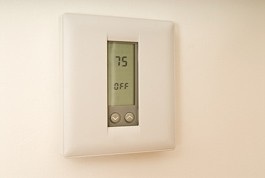 RISMEDIA, July 1, 2009-(MCT)-Q: I heard you talk to a group of homeowners recently and you recommended that people use programmable thermostats to save energy. However, I saw an article a while ago where some researchers said that these products really don’t save money and they don’t think they’re very useful. What’s the real story?
RISMEDIA, July 1, 2009-(MCT)-Q: I heard you talk to a group of homeowners recently and you recommended that people use programmable thermostats to save energy. However, I saw an article a while ago where some researchers said that these products really don’t save money and they don’t think they’re very useful. What’s the real story?
A: While I do think that a programmable (also called set-back or automatic) thermostat can save money and keep your home more comfortable, it’s important to note that it will only do these things if you use it the right way.
What a programmable thermostat does is adjust your air-conditioner or heating settings to match your lifestyle according to the schedule you set up. For example, during the summer, you might like to sleep with the windows open so you set the thermostat to turn the air conditioner off between 9 p.m. and 5 a.m. You set it to turn the air conditioner on at 78 degrees at 5 a.m. and leave it at that setting until 8 a.m. when the family leaves for the day. You program it to raise the thermostat at that time to 82 degrees. And you adjust it to turn on the air conditioner back at 78 degrees starting at 4:30 p.m. when the kids get home from school.
Wait a minute, you might say. You can do all that yourself. Why do you need a fancy thermostat to do all this? Basically, people love these thermostats not only because they are fairly low-cost to buy and easy to operate, but most importantly, they don’t forget to make the thermostat adjustments you want. You can even program most of the models to make different settings on weekends and during times when you’re on vacation. There’s no more getting out of bed at 11 p.m. because it’s too cold and you forgot to turn the thermostat down, or sitting at work in the middle of the day and suddenly remembering that the air conditioner is cranking out all that cold air into an empty house because you left the setting on too low.
Why this doesn’t work for some people is that they think simply having a programmable thermostat installed in their home means that their energy bills will go down. All that thermostat can do is regulate the cooling or heating equipment to the most efficient levels, and so it is important that you program it to meet your family’s needs and don’t keep adjusting it to less efficient settings to disrupt your energy-saving strategy. I know that people often set up the proper thermostat levels, but constantly override the settings when they’re uncomfortable, thus reducing the potential savings.
I’ve seen studies that report that the typical homeowner can save $150 to $200 annually on energy bills by properly setting the thermostat to match their cooling and heating needs. That will pay back the cost of an average setback thermostat in just a few months, and help keep your home more comfortable in the cooling and heating seasons.
Research has shown that for every degree you can raise the thermostat setting in summer or lower it in winter, you can save anywhere from 2 to 10% on energy costs (the number varies greatly depending on the climate, the overall energy efficiency of your home and other factors).
You can learn a lot more about these thermostats, including details on the various types of models available, at http://www.energystar.gov/ – thermostats. But remember, just buying one won’t save any money. Take the time to pre-set the unit to match your family’s cooling and heating needs, and it can make a big difference. Regardless of the money savings, however, I like the programmable thermostat we have for the way it helps my family enjoy our home more. It’s hard to put a price on comfort.
Ken Sheinkopf is a communications specialist with the American Solar Energy Society (www.ases.org).
©2009, McClatchy-Tribune Information Services.










